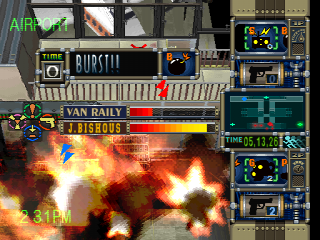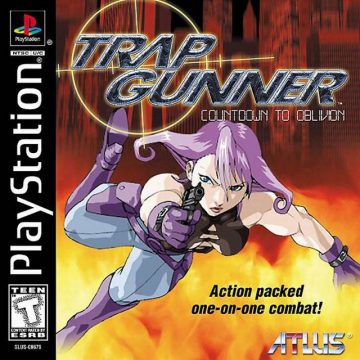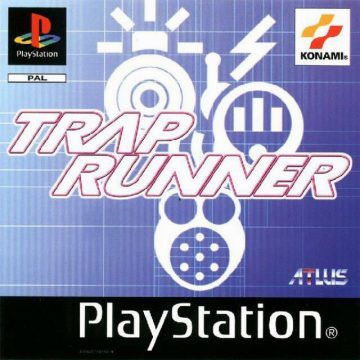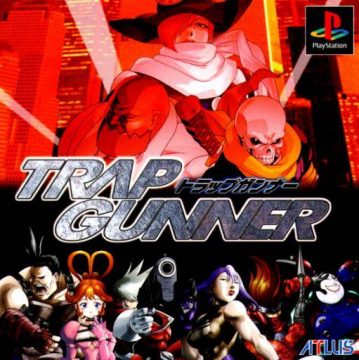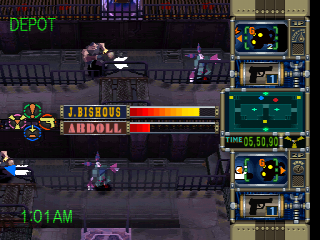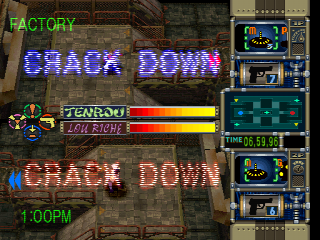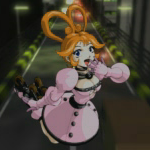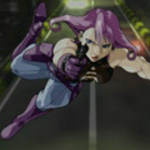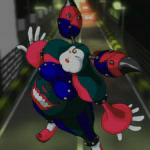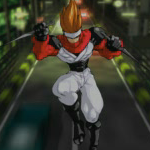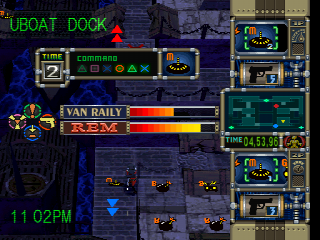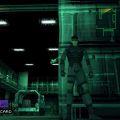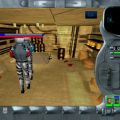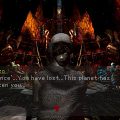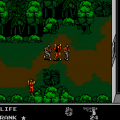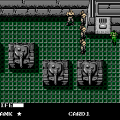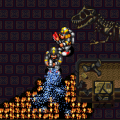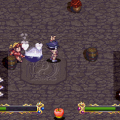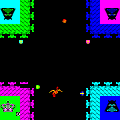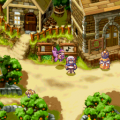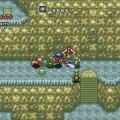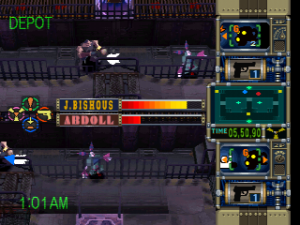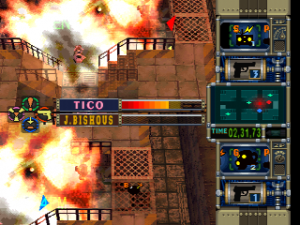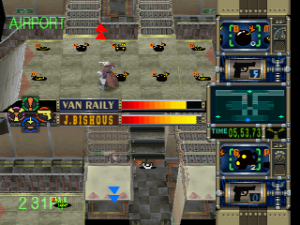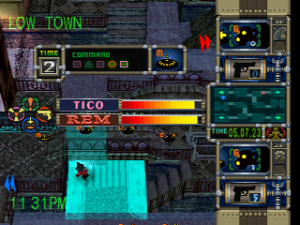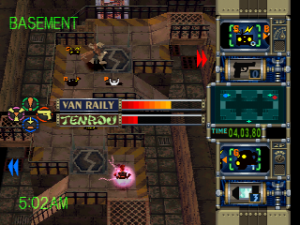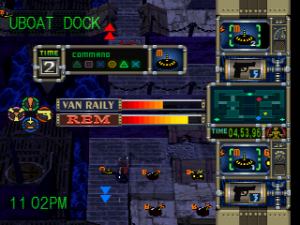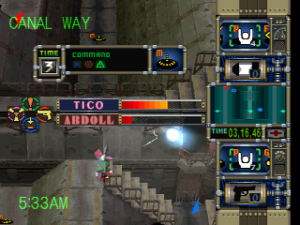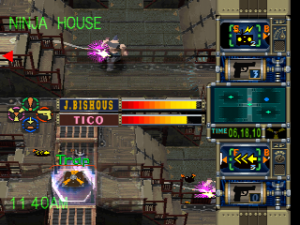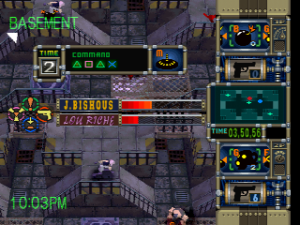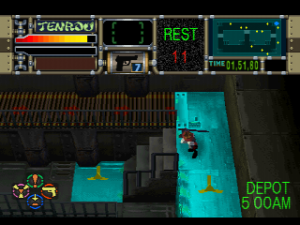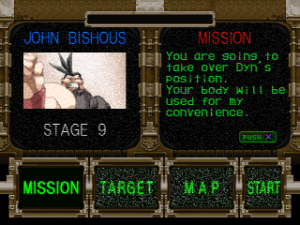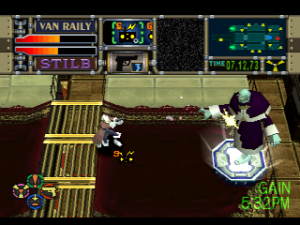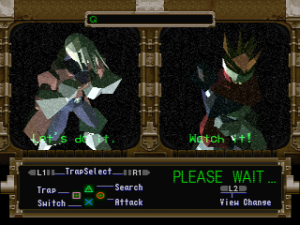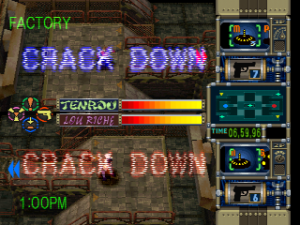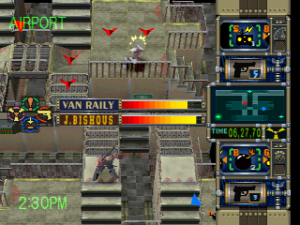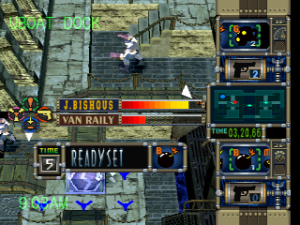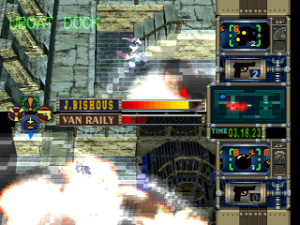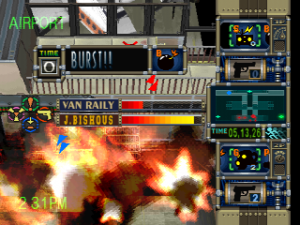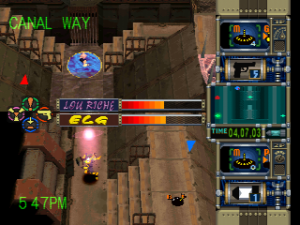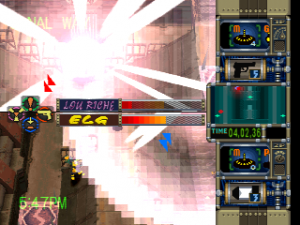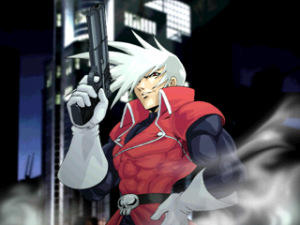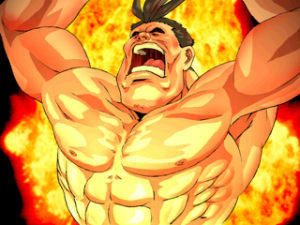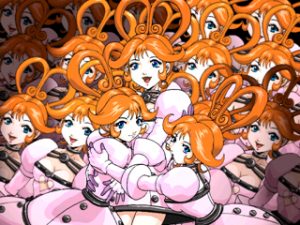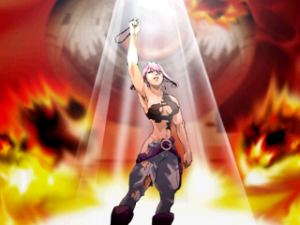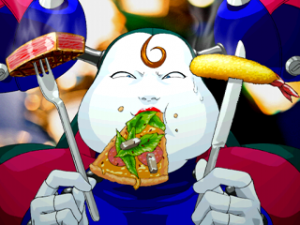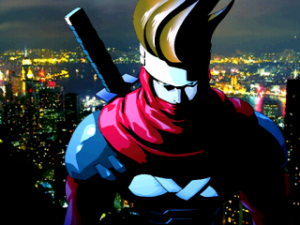Assigning a genre to the PlayStation game Trap Gunner is no easy task, but it can best be described as a hybrid strategy/shooting/fighting game. This is a one-on-one combat game published by Atlus and created by a relatively unknown Japanese developer named Racdym (since renamed to Racjin). Some may recognize Racdym from their earlier success with Snowboard Kids on the Nintendo 64. The name Racjin is probably most well-known as the developer of Wizardry: Tale of the Forsaken Land on the PlayStation 2. This company never had their name printed on the boxes of their games and would only be known about by people who noticed Racdym’s logo upon turning on a game or seeing copyright information for Racjin in the credits or title screen.
Trap Gunner pits several special agents who are skilled in assassination and demolitions against one another in a fight to the death. The game features a story mode, a player vs. player mode, a player vs. computer mode, and a tutorial. This tutorial mode is a great way to learn how to play the game as it consists of several narrated videos which explain the basic concepts of playing as well as some hints at the more advanced tactics available to the player. The game is simple enough for new players to get into a match and have a fun time, but there are certainly plenty of tricks for the more inclined player to learn.
There are a total of nine playable characters in the game – six main characters and three unlockable sub-bosses who are basically slightly beefed up palette/model swaps of some of the regular characters. Each of the characters have varied walking and attacking speeds as well as differing amounts of health. Each agent is equipped with a projectile weapon and is capable of performing a melee attack when close to their opponent. They also have their own unique sets of traps that they are equipped with at the start of a match. The main characters feel quite different from one another and the differences in their weapons and initial traps allow the player to find a style they are comfortable with.
Traps play the central role in the game and there are six types available with each character starting a match with three different types in their inventory. The Switch Detonator is a remotely detonated explosive which can be set off by the player at any time, making it one of the deadliest traps. The Mine is exactly what it sounds like; these will go off if the opponent steps on one. The Bomb can only be set off in conjunction with a Switch Detonator or a nearby mine explosion. The Force Panel is a trap which propels the opponent in one of four directions (determined by its placement) and is useful for flinging someone into deadlier traps. The Pitfall trap renders a player immobile for a few seconds and can be useful for several situations, including the use of the last trap type – the Gas. The Gas trap will always activate itself automatically a few seconds after being placed. It emits a purple gas cloud that will damage anyone who comes into contact with it as well as slowing their movement for several seconds afterwards. Multiple traps can be placed near each other and set off simultaneously for a massively damaging combo attack. A player cannot set off their own traps by walking over them, but will take full damage if caught in their explosion.
So, you have an area of the map covered in traps, but what does your opponent see on their screen? Absolutely nothing; this brings us to another major aspect of the game – detecting and disarming traps. In order to see an enemy’s traps you need to hold a button to enter a trap detection mode in which your character moves at a slow pace while scanning for nearby traps. Any detected traps will now be displayed on your screen with a generic icon, meaning you won’t know what specific trap is planted there and may risk having a Switch Detonator blown in your face if you attempt to disarm it. The game is played in split-screen and there is no link cable support, so this aspect of the game can get a bit messed up by people watching each other’s screens, but it doesn’t really hurt the overall experience much because there is always a lot going on. Disarming traps not only removes their threat but also gives some health back to the player and permanently removes that trap from the opponent’s inventory. In order to disarm a trap a sequence of button presses must be performed within a short amount of time, you can probably guess what happens if you mess this up. It is best to disarm traps while your opponent is distracted because if they shoot you during the disarming sequence, the trap will automatically activate.
The guns in Trap Gunner are best used for interrupting the actions of your opponent, although some characters can dish out a lot of damage with just their weapon. Two of the characters are capable of causing a knock-down with their projectile; this is very convenient when used against an enemy equipped with the Plasma Unit. Ah yes, the most important item in the game – known simply as the “Unit”, it is a weapon capable of firing a massive ball of plasma which homes in on the opponent and will remove a huge chunk of life on contact. This can only be obtained in the middle of a match once it has spawned at one of the Power Object Delivery Systems (P.O.D.S., how clever). It carries three shots which can only be fired one at a time and requires several seconds of charge time before being fired. Sound effects are important here as you can hear the Unit being charged as well as hearing the giant plasma ball approach you from any part of the stage. The game gets hectic when this thing is fired off because cautious tactics are no longer viable. Getting hit by an attack from the unit can take off nearly half of your health, so you are gonna want to get away from it which requires you to be on the move constantly as it tracks you anywhere. One way to avoid it is to hide under a bridge which will then be destroyed by the plasma ball. It is also possible to run away until it dissipates or to cancel it out with a bomb explosion. Sometimes it is better to suffer a minor explosion to avoid the massive damage caused by a Unit attack. Of course all this aimless running leads to players wandering right into their opponent’s traps as they attempt to evade the plasma ball. Get ready to laugh at your opponent as they step into your Pitfall trap placed conveniently next to a bridge and watch them eat plasma, or maybe scream when you step on a Force Panel leading you into five Bombs and a Switch Detonator. Not all hope is lost when the opponent obtains the Unit as it can be destroyed by knocking their character down, cancelling the currently active plasma blast in the process.
The maps in the game are all pretty similar in style and appearance. Most consist of two floors connected by staircases and ramps and several bridges which can be used to avoid Unit attacks. A few contain conveyor belts and neutral traps such as rocket launchers as well, but there is little overall variety. Each map contains several P.O.D.S. for item distribution which may deposit equippable traps, powerups for temporary speed increases or invincibility, health pickups, and the Unit weapon. There is a map on the side of the screen which shows the location of any available items as well as an icon displaying the current item. There are twelve initial maps featuring highly original names such as “Port”, “Factory”, “Depot”, and “Basement”. Take a look at any of these maps during gameplay and you probably won’t be able to identify which one you are playing on because they look very similar and have almost no defining characteristics. Four additional maps can be unlocked upon completion of the story mode.
The story mode revolves around an evil organization known as Gain. They are a powerful criminal organization which controls the supply of a substance known as “Cell-147” made from cells from the blood of an ancient monster. This substance is said to grant immortality to those who use it, but is known to cause dire side effects. Gain hopes to achieve global domination, but fears that six agents may pose a threat to their plans. Gain comes up with a plan to individually influence each of the agents into fighting the others.
Characters
Van Raily
A freelance agent who contracted a fatal disease with no known cure as a child. He is kept alive by an injection of Cell-147 given by his sister Rem who ran away shortly after administering it. Van accepts all sorts of dirty work in hopes of finding his sister. Uses a handgun in combat.
John Bishous
A police lieutenant with a bad temper. His close friend and partner Dyn disappeared after an investigation of Gain. Upon hearing a rumor that Dyn had been seen working for Gain, John decides to go undercover as an agent of Gain to find the truth about his partner. Has a lot of stamina and fights with a shotgun.
Tico
A spy android developed by the CIA. Tico has simple emotions and was never meant to be able to think on her own, however she was coaxed into joining Gain after they offered her some ice cream. Gain plans to mass-produce the Tico unit and sneak them into foreign countries to kill world leaders. Capable of firing a homing missile from her butt.
Lou Riche
A Green Beret who’s parents were killed by Gain when she was a child. When sent on a mission to spy on Gain she managed to discover that her parents were killed by the Gain executive known as Elg. Lou will do whatever it takes to get to Elg and avenge the death of her parents. Fights with a handgun which she can unload very quickly.
Abdoll Relin
A mutant created by Gain using bio-technology and Cell-147. Her past is uknown, but in her present state she is a vicious killer who’s only concern is to hunt her victims down and crush them. Abdoll is hardly capable of following orders outside of simply killing and eventually turns against Gain. Capable of shooting her own hands as a projectile, which quickly regenerate.
Story mode has you take one of the six main characters through fights against the other agents as well as a sub-boss and final boss fight. The action is broken up by a briefing screen in which Gain explains why you should be killing your target along with a description of the enemy agent and the current map. There is some brief text-only dialogue at the end of a match depicting the final moments of the encounter. You can read about Van shooting a guy in the head or Abdoll crushing someone’s face under her foot. Some of the dialogue is unintentionally hilarious such as “your body will be used for my convenience.” There are a couple of non-combat stages thrown into the story mode for variety which involve disarming traps or collecting canisters of Cell-147. These stages as well as the final boss’s stage switch the camera to a full-screen view of your character’s screen. The final boss of the game is Stilb, the leader of Gain. He is a stationary target – a giant, green-skinned, mutated man who can fire plasma shots from his hand and charge up a Unit attack from his own body. You start the final stage without any traps and will have to navigate past some laser cannons and rocket launchers to find some. The final battle plays out a lot differently from a normal match because you are basically just detonating traps around Stilb while avoiding attacks. The endings consist of a couple of still-shot anime style screens with a text overlay explaining what your character is going to do next with their life. Finishing the game with Van, John, and Tenrou unlocks the three sub-bosses for use in the other modes.
Trap Gunner may seem like a game meant for multiplayer battles, but the game is absolutely worth trying on your own. While the story mode doesn’t do anything revolutionary, the AI of the computer opponents is actually very good. The CPU puts up a competent fight and knows how to play the game properly. They will create deadly trap combos, search for and disarm your traps at opportune times, and they know how to make good use of the Unit as well as how to avoid an attack from it. Compare this to most one-on-one fighting games in which the CPU tends to use random attacks and occasionally reads your input to slam you with a perfectly timed super move. There are a few holes in the AI, for instance they will usually run for an item as soon as one has spawned and they tend to walk right into any traps you have planted around the item spawn point. They also seem very determined to walk up certain sloped surfaces, no matter how many times you shoot at them causing them to fall down and try to climb the same surface again with you standing right next to them. There are also certain mind games that can be played on human opponents that won’t necessarily make sense to use on the computer, but this is something that can’t really be helped. Overall, though, the CPU opponents are very competent and make for a satisfying single-player experience.
The game has a mostly serious tone throughout the package, ice cream loving android girl aside. Static / white noise is a common theme, with a static filter applied to almost all screens outside of gameplay and a full screen of static with accompanying sound effects used as a short loading screen. The graphics of the game are passable, it’s easy enough to tell what is going on at any given moment and to distinguish between traps – although the traps consist of flat, low-resolution images. The stages are sadly lacking in terms of definable characteristics, but they get the job done while not looking too ugly. The character models are pretty blocky which can be seen up-close during the pre-match loading screen, but it isn’t so noticeable when actually playing the game thanks to the zoomed-out overhead camera. On the plus side, the explosions look great, with flames filling the screen followed by thick, black smoke. The brilliant burst of light which accompanies a hit from the Plasma Unit is another noteworthy sight to behold. The sound effects that accompany these attacks are pretty convincing as well. Each character has a unique voice, but they are only used to yell out in pain when damaged, there is no spoken dialogue in the game aside from an announcer at the beginning and end of a match. The songs in the game span many genres including rock, jazz, and even some dance style music. The character select screen has a vocal track which is sort of corny, but kind of catchy too. The music in general is not extremely memorable, but there are a few nice tracks which may stay in your head afterwards.
Trap Gunner is a truly unique game; very few others play anything like it. The closest comparison dates back to 1984 – Spy vs. Spy, developed by First Star Software. That game was a two-player split screen game in which the spies searched through furniture in multiple rooms to find the required items to win the game. Traps could be placed in the furniture to damage the opponent, and could even be disarmed with the proper item. Melee combat was also possible when the two spies were in the same room. Some inspiration likely came from Bomberman, but the games are actually quite different from one another. Racdym would actually go on to develop a few Bomberman games for Hudson under their new name, Racjin. Sega’s Crack Down is another possible inspiration, despite not being a versus style game. That game involved guns and bombs and also displayed both players screens as well as a radar/map at all times. Each match of Trap Gunner is started with the announcer saying “Get ready… crack down.” One more possible inspiration could have been Tecmo’s Deception, a first-person RPG released a couple years earlier in which the player had to place traps throughout a map to kill enemies. In terms of games which came out after Trap Gunner, the closest example would be Shadow Assault: Tenchu, developed by From Software in 2008. The game’s multiplayer mode allows for up to four players and involves traps, but takes place on a single screen and is closer in nature to Bomberman. It is also a pretty dumb game, and nowhere near as good or strategic as Trap Gunner. It would be nice to see a sequel or port of Trap Gunner come along because it could really benefit from the single-screen nature of online gaming.
